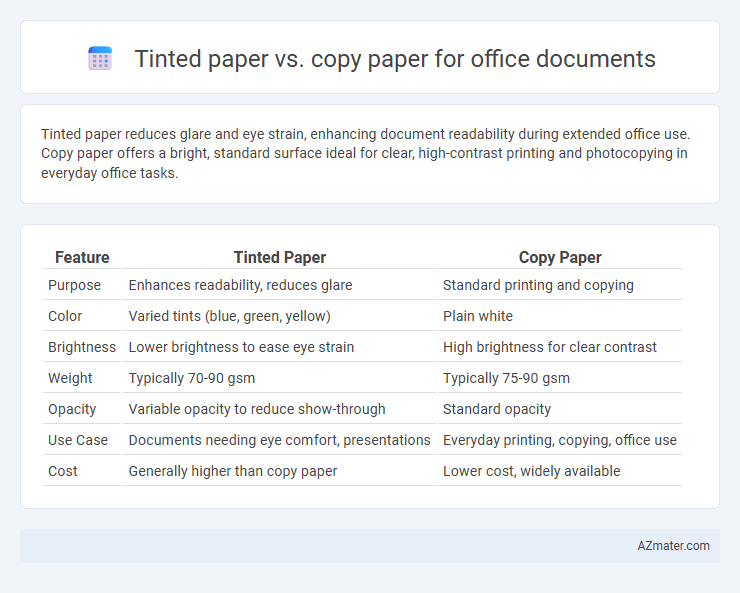Tinted paper reduces glare and eye strain, enhancing document readability during extended office use. Copy paper offers a bright, standard surface ideal for clear, high-contrast printing and photocopying in everyday office tasks.
Table of Comparison
| Feature | Tinted Paper | Copy Paper |
|---|---|---|
| Purpose | Enhances readability, reduces glare | Standard printing and copying |
| Color | Varied tints (blue, green, yellow) | Plain white |
| Brightness | Lower brightness to ease eye strain | High brightness for clear contrast |
| Weight | Typically 70-90 gsm | Typically 75-90 gsm |
| Opacity | Variable opacity to reduce show-through | Standard opacity |
| Use Case | Documents needing eye comfort, presentations | Everyday printing, copying, office use |
| Cost | Generally higher than copy paper | Lower cost, widely available |
Introduction to Tinted Paper and Copy Paper
Tinted paper is colored or lightly shaded paper designed to reduce glare and eye strain during prolonged reading, making it ideal for documents requiring enhanced readability in office settings. Copy paper, typically white and standard in weight and quality, serves as the most common choice for everyday printing and photocopying tasks in offices. The selection between tinted paper and copy paper affects document presentation, readability, and eye comfort in professional environments.
Defining Tinted Paper and Its Common Uses
Tinted paper is colored or lightly shaded paper used to reduce glare and improve readability for office documents, often in hues like pastel blue, green, or yellow. Common uses of tinted paper include printing reports, memos, and forms requiring differentiation or emphasis, enhancing visual organization and reducing eye strain. Compared to standard white copy paper, tinted paper aids in categorizing documents and increasing attention to specific information.
What Is Copy Paper? Characteristics and Applications
Copy paper is a versatile, standard white paper designed primarily for office printers and copiers, featuring a smooth surface and medium weight typically around 20 lb (75 gsm). It offers reliable ink absorption and crisp text reproduction, making it suitable for everyday printing tasks, including memos, reports, and forms. Copy paper's affordability and compatibility with most office machines make it an essential consumable in business environments.
Visual Appeal: How Color Influences Document Presentation
Tinted paper enhances visual appeal by adding subtle color tones that make office documents stand out and improve readability, especially under various lighting conditions. Copy paper, typically bright white, offers a neutral background that ensures text clarity but may cause eye strain during extended reading. Choosing tinted paper can create a more engaging presentation, reduce glare, and evoke a professional and distinctive look for important reports or proposals.
Readability and Eye Strain: Comparing User Experience
Tinted paper reduces glare and enhances contrast, improving readability and minimizing eye strain during prolonged document review compared to standard white copy paper. Studies show that soft pastel tints, such as light blue or green, can significantly decrease visual fatigue in office environments. Users often report increased comfort and better focus when using tinted paper for extended reading tasks.
Professionalism and Branding in Office Documents
Tinted paper enhances professionalism and branding in office documents by providing a distinctive visual appeal that reinforces corporate identity and captures recipient attention. Unlike standard copy paper, tinted options offer improved readability and can be aligned with brand colors, creating a cohesive and polished presentation. This subtle yet effective differentiation boosts perceived value and supports consistent brand messaging across all professional communications.
Cost Considerations: Tinted Paper vs Copy Paper
Tinted paper generally costs more per ream than standard copy paper due to its specialized coloring process and lower production volume. Copy paper remains the more budget-friendly option for high-volume office printing, offering consistent quality at a lower price point. Choosing tinted paper can increase expenses significantly in large-scale printing tasks, impacting overall office supply costs.
Environmental Impact and Sustainability Factors
Tinted paper often contains dyes and pigments that can increase chemical waste and reduce recyclability, negatively impacting environmental sustainability compared to standard copy paper. Copy paper is typically made from sustainably sourced wood fibers and is easier to recycle, making it a more eco-friendly choice for office documentation. Choosing copy paper over tinted paper contributes to lower carbon footprints and supports green office practices through better recyclability and reduced chemical use.
When to Choose Tinted Paper Over Copy Paper
Tinted paper enhances document readability by reducing glare and eye strain, making it ideal for long reading sessions or when highlighting specific sections of office documents. It is preferred in environments where color differentiation aids in organizing files, such as color-coding reports, memos, or forms. Choosing tinted paper over standard copy paper improves document clarity and retention, especially for presentations or client-facing materials requiring visual emphasis.
Conclusion: Selecting the Best Paper for Office Needs
Choosing tinted paper for office documents can enhance readability and reduce eye strain during extended viewing, making it ideal for presentations and reports requiring visual comfort. Copy paper remains the versatile, cost-effective choice suitable for everyday printing, copying, and faxing needs due to its compatibility with most office printers and copiers. Evaluating specific office tasks, budget constraints, and visual requirements ensures selecting the best paper that balances functionality, professional appearance, and user comfort.

Infographic: Tinted paper vs Copy paper for Office document
 azmater.com
azmater.com